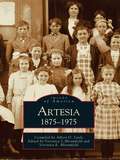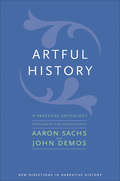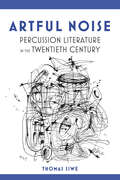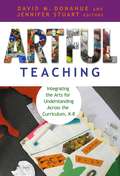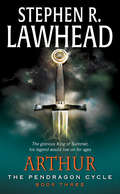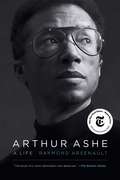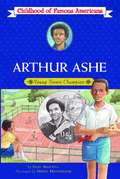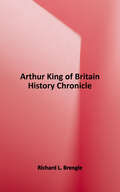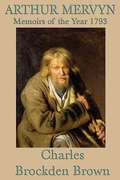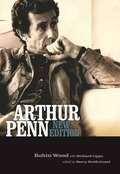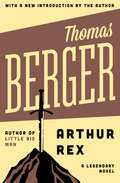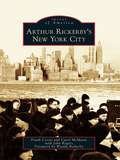- Table View
- List View
Artesia: 1875-1975 (Images of America)
by Albert O. Little Veronica L. Bloomfield Veronica E. BloomfieldThis three-generation endeavor started in 1975 when Albert O. Little, known for his dedication to the community as "Mr. Artesia," began working on two volumes of history: The Artesians: How It Began One Hundred Years Ago and The Artesians: Twenty Years of Incorporation. He gathered photographs and considerable narrative material, hoping that one day he would be able to share his historical knowledge and his love for the city with the rest of the community in a pictorial history. Sadly, while in the process of putting it together, he passed away. Nothing would have made him more proud than to have seen this project be completed and made available to the residents of Artesia. Veronica Little Bloomfield is Albert Little's daughter, and coauthor Veronica Elizabeth Bloomfield is his granddaughter. Together, they have honored his legacy of love and dedication by going through old pictures, talking about the faces and places that defined Artesia, and compilingthese materials into a history. The images and words in this text come from Little's archives and the many friends and associates he had in this town over the years. Images of ranchos, farming, schools and homes, incorporation and consolidation, and of course, the Artesian wells for which the city wasnamed, document the early agricultural community that was Artesia.
Artful Breakdowns: The Comics of Art Spiegelman (Tom Inge Series on Comics Artists)
by Georgiana Banita and Lee KonstantinouContributions by Georgiana Banita, Colin Beineke, Harriet Earle, Ariela Freedman, Liza Futerman, Shawn Gilmore, Sarah Hamblin, Cara Koehler, Lee Konstantinou, Patrick Lawrence, Philip Smith, and Kent Worcester A carefully curated, wide-ranging edited volume tracing Art Spiegelman’s exceptional trajectory from underground rebellion to mainstream success, Artful Breakdowns: The Comics of Art Spiegelman reveals his key role in the rise of comics as an art form and of the cartoonist as artist. The collection grapples with Spiegelman’s astonishing versatility, from his irreverent underground strips, influential avant-garde magazine RAW, the expressionist style of the comics classic Maus, the illustrations to the Jazz Age poem “The Wild Party,” and his response to the September 11 terrorist attacks to his iconic cover art for the New Yorker, his children’s books, and various cross-media collaborations. The twelve chapters cut across Spiegelman’s career to document continuities and ruptures that the intense focus on Maus has obscured, yielding an array of original readings. Spiegelman’s predilection for collage, improvisation, and the potent protest of silence shows his allegiance to modernist art. His cultural critique and anticapitalist, antimilitary positions shed light on his vocal public persona, while his deft intertextual strategies of mixing media archives, from comics to photography and film, amplify the poignance of his works. Developing new approaches to Spiegelman’s comics—such as the publication history of Maus, the history of immigration and xenophobia, and the cartoonist’s elevation of children’s comics—the collection leaves no doubt that despite the accolades his accessible comics have garnered, we have yet to grasp the full range of Spiegelman’s achievements in the realm of comics and beyond.
Artful History: A Practical Anthology (New Directions in Narrative History)
by John Demos Aaron SachsA collection of memorable, stirring, and eloquent historical essays, designed to help any historian write more artfully Is there any reason that serious historical scholarship cannot receive literary expression? Isn&’t it possible that the most committed empiricists and postmodernists might both achieve better results by thinking of writing as a craft, rather than just a means of packaging research? This book compiles some of the most compelling efforts to make history writing eloquent, stirring, and memorable, in the realms of both practice and theory. The authors included here prove the great potential of approaching the writing of history as a literary art, even as they retain a commitment to rigorous scholarship. The collection shows how historians can aspire to find a form that matches and enhances their substance, nudging readers toward what historian John Clive called the &“spell that lingers in the memory and is conducive not just to reading but to rereading.&” With selections from: Jonathan Spence, Simon Schama, Saidiya Hartman, Wendy Warren, Jill Lepore, Louis Masur, Jane Kamensky, and John Demos, among others.
Artful Noise: Percussion Literature in the Twentieth Century (Music in American Life #502)
by Thomas SiweTwentieth-century composers created thousands of original works for solo percussion and percussion ensemble. Concise and ideal for the classroom, Artful Noise offers an essential and much-needed survey of this unique literature. Percussionist Thomas Siwe organizes and analyzes the groundbreaking musical literature that arose during the twentieth century. Focusing on innovations in style and the evolution of the percussion ensemble, Siwe offers a historical overview that connects the music to scoring techniques, new instrumentation and evolving technologies as well as world events. Discussions of representative pieces by seminal composers examines the resources a work requires, its construction, and how it relates to other styles that developed during the same period. In addition, Siwe details the form and purpose of many of the compositions while providing background information on noteworthy artists. Each chapter is supported with musical examples and concludes with a short list of related works specifically designed to steer musicians and instructors alike toward profitable explorations of composers, styles, and eras.
Artful Teaching: Integrating the Arts for Understanding Across the Curriculum
by David M. Donahue Jennifer StuartThe authors in this volume share exemplary arts-integration practices across the K–8 curriculum. Rather than providing formulas or scripts to be followed, they carefully describe how the arts offer an entry point for gaining insight into why and how students learn. The book includes rich and lively examples of public school teachers integrating visual arts, music, drama, and dance with subject matter, including English, social studies, science, and mathematics. Readers will come away with a deeper understanding of why and how to use the arts every day, in every school, to reach every child. Both a practitioner’s guide and a school reform model, this important book: <P><P> Explains how arts integration across the K–8 curriculum contributes to student learning. Features examples of how integrated arts education functions in classrooms when it is done well. Explores intensive teacher-education and principal-training programs now underway in several higher education institutions. Offers concrete ideas for educators who are looking to strengthen their own skills and improve student opportunities for learning.
Artful Virtue: The Interplay of the Beautiful and the Good in the Scottish Enlightenment
by Leslie Ellen BrownDuring the Scottish Enlightenment the relationship between aesthetics and ethics became deeply ingrained: beauty was the sensible manifestation of virtue; the fine arts represented the actions of a virtuous mind; to deeply understand artful and natural beauty was to identify with moral beauty; and the aesthetic experience was indispensable in making value judgments. This book reveals the history of how the Scots applied the vast landscape of moral philosophy to the specific territories of beauty - in nature, aesthetics and ethics - in the eighteenth century. The author explores a wide variety of sources, from academic lectures and institutional record, to more popular texts such as newspapers and pamphlets, to show how the idea that beauty and art made individuals and society more virtuous was elevated and understood in Scottish society.
Artfully Yours
by Joanna LowellSparks fly between a lordly art critic and a lady forger in this enthralling Victorian historical romance from the author of The Runaway Duchess. Nina Finch isn't suited for a life of crime. Raised by her art-forger brother, she can paint like Botticelli. But she'd so much rather be baking gooseberry tarts. She finally has the money she needs to open her own bakery. Unfortunately, her brother's carelessness lands her—and their forgeries—directly under the nose of London's most discerning art critic, Alan De'Ath. De'Ath knows the paintings are fake. He doesn't know that Nina had a hand in their creation. In fact, he offers her a job in his household. Accepting it is the most dangerous thing she has ever done.... Alan takes pride in seeing things other people miss. He plans to catch the forger and cement his reputation. There's only one problem: the closer he gets to the beguiling woman he hired, the less he trusts his perspective. Nina isn't what she seems. But despite their false start, she just might hold the real key to his heart. As Nina and Alan&’s attraction grows, divided loyalties threaten to pull them apart and shatter their worlds. They&’ll lose everything, or discover how powerful true love can be....
Arthik Vikas Ki Samjh
by National Council Of Educational Research TrainingThis book prescribed by central board of secondary education, India for the students of class 10th subject Social Science, studying through hindi medium. This accessible version of the book doesn’t leave any part of the book. The book is handy companion of the school and university students desiring to read facts in interesting way. NCERT books are must read for aspirants of competitive and job related examinations in India.
Arthuna Gram
by Ravindra D. PandyaPandya brings out the history of Arthuna gram in this book. The book tells about the archaeology of Bagar Region of Rajasthan. Although writer is not a historian, he has done a marvelous job in doing a deep research on the region.
Arthur (The Pendragon Cycle #3)
by Stephen R. LawheadIn a forgotten age of darkness, a magnificent king arose to light the landThey called him unfit to rule, a lowborn, callow boy, Uther's bastard. But his coming had been foretold in the songs of the bard Taliesin. And he had learned powerful secrets at the knee of the mystical sage Merlin.He was ARTHUR--Pendragon of the Island of the Mighty--who would rise to legendary greatness in a Britain torn by violence, greed, and war; who would usher in a glorious reign of peace and prosperity; and who would fall in a desperate attempt to save the one he loved more than life.ARTHUR"Evocate . . . intriguing . . . enthralling." -Locus
Arthur Ashe: A Life
by Raymond ArsenaultThe first comprehensive, authoritative biography of American icon Arthur Ashe—the Jackie Robinson of men’s tennis—a pioneering athlete who, after breaking the color barrier, went on to become an influential civil rights activist and public intellectual. <p><p> Born in Richmond, Virginia, in 1943, by the age of eleven, Arthur Ashe was one of the state's most talented black tennis players. Jim Crow restrictions barred Ashe from competing with whites. Still, in 1960 he won the National Junior Indoor singles title, which led to a tennis scholarship at UCLA. He became the first African American to play for the US Davis Cup team in 1963, and two years later he won the NCAA singles championship. In 1968, he won both the US Amateur title and the first US Open title, rising to a number one national ranking. Turning professional in 1969, he soon became one of the world’s most successful tennis stars, winning the Australian Open in 1970 and Wimbledon in 1975. After retiring in 1980, he served four years as the US Davis Cup captain and was inducted into the International Tennis Hall of Fame in 1985. <p> In this revelatory biography, Raymond Arsenault chronicles Ashe’s rise to stardom on the court. But much of the book explores his off-court career as a human rights activist, philanthropist, broadcaster, writer, businessman, and celebrity. In the 1970s and 1980s, Ashe gained renown as an advocate for sportsmanship, education, racial equality, and the elimination of apartheid in South Africa. But from 1979 on, he was forced to deal with a serious heart condition that led to multiple surgeries and blood transfusions, one of which left him HIV-positive. <p> In 1988, after completing a three-volume history of African-American athletes, he was diagnosed with AIDS, a condition he revealed only four years later. After devoting the last ten months of his life to AIDS activism, he died in February 1993 at the age of forty-nine, leaving an inspiring legacy of dignity, integrity, and active citizenship. <p> Based on prodigious research, including more than one hundred interviews, Raymond Arsenault’s insightful and compelling biography puts Ashe in the context of both his time and the long struggle of African-American athletes seeking equal opportunity and respect.
Arthur Ashe: Tennis and Justice in the Civil Rights Era
by Eric Allen HallThe first scholarly biography of one of the most famous athletes of our time shows how Ashe worked for civil rights while playing a country-club sport in a white man’s world.Winner of the CHOICE Outstanding Academic Title of the Choice ACRLArthur Ashe explains how this iconic African American tennis player overcame racial and class barriers to reach the top of the tennis world in the 1960s and 1970s. But more important, it follows Ashe’s evolution as an activist who had to contend with the shift from civil rights to Black Power. Off the court, and in the arena of international politics, Ashe positioned himself at the center of the black freedom movement, negotiating the poles of black nationalism and assimilation into white society. Fiercely independent and protective of his public image, he navigated the thin line between conservatives and liberals, reactionaries and radicals, the sports establishment and the black cause.Eric Allen Hall’s work examines Ashe’s life as a struggle against adversity but also a negotiation between the comforts—perhaps requirements—of tennis-star status and the felt obligation to protest the discriminatory barriers the white world constructed to keep black people "in their place."Drawing on coverage of Ashe’s athletic career and social activism in domestic and international publications, archives including the Ashe Papers, and a variety of published memoirs and interviews, Hall has created an intimate, nuanced portrait of a great athlete who stood at the crossroads of sports and equal justice.
Arthur Ashe: Young Tennis Champion (Childhood of Famous Americans Series)
by Paul Mantell Meryl HendersonChildhood of Famous Americans One of the most popular series ever published for young Americans, these classics have been praised alike by parents, teachers, and librarians. With these lively, inspiring, fictionalized biographies -- easily read by children of eight and up -- today's youngster is swept right into history.
Arthur Erickson
by David StouckArthur Erickson, Canada's pre-eminent philosopher architect, was renowned internationally for his innovative approach to landscape, his genius for spatial composition, and his epic vision of architecture for people. Among his most celebrated large-scale works are three that helped to define Vancouver's urban landscape: Simon Fraser University, on Burnaby Mountain; the Robson Square complex at the heart of the city; and the exquisite Museum of Anthropology at the University of British Columbia. Travel was key to Erickson's creative process; floating high above the clouds on extended airline flights, he made preliminary drawings on vellum with his fine-point black felt-tip pen, designing influential works not only for other parts of Canada-including Toronto's widely admired Roy Thomson Hall--but for sites in the U.S., Britain, and the Middle and Far East. Erickson worked chiefly in concrete, which he called "the marble of our times," and wherever they appear, his buildings move the spirit with their poetic freshness and their mission to inspire. But he was also a controversial figure, more than once attracting the ire of his fellow architects, and his professional achievements were tarnished by the excesses of a complicated personal life that resulted in a series of tawdry bankruptcies. In a fall from grace that recalls a Greek tragedy, Canada's great architect-a handsome, elegant man who lived like a millionaire and counted among his close friends Pierre Trudeau and Elizabeth Taylor-eventually became homeless and penniless.This first full biography of Erickson, who died in 2009 at the age of eighty-four, traces the architect's life from its modest origins to his emergence on the world stage. Author David Stouck, acclaimed for his earlier biographies of Ethel Wilson and Sinclair Ross, demonstrates here once again why his work has been praised as imaginative, incisive and compelling. Grounded in interviews with Erickson and his family, friends and clients, as well as the resources of extensive public archives, TITLE is both an intimate portrait of the man and a stirring account of how Erickson made his buildings work. Beautifully written and superbly researched, it is also a provocative look at the phenomenon of cultural heroes and the nature of what we call "genius."
Arthur H. Westing: Pioneer on the Environmental Impact of War (SpringerBriefs on Pioneers in Science and Practice #1)
by Arthur H. WestingSince the 1960s the environment has become an issue of increasing public concern in North America and elsewhere. Triggered by the Second Indochina War (Vietnam Conflict) of 1961-1975, and further encouraged by the International Conference on the Human Environment, held in Stockholm in 1972, the environmental impact of war emerged and grew as a topic of research in the natural and the social sciences. And in the late 1980s this led additionally to a focus and debate on environmental security. Arthur Westing, a forest ecologist, was a major pioneer contributing and framing both of those debates conceptually, theoretically, and empirically, starting with Harvest of Death: Chemical Warfare in Vietnam and Cambodia (1972) (co-authored with wildlife biologist E.W. Pfeiffer and others). As a Senior Researcher at the Stockholm and Oslo International Peace Research Institutes (SIPRI and PRIO), and as a Professor of Ecology at Windham and Hampshire Colleges, Westing authored and edited books on Ecological Consequences of the Second Indochina War (1976), Weapons of Mass Destruction and the Environment (1977), Warfare in a Fragile World: Military Impact on the Human Environment (1980), Herbicides in War: the Long-term Ecological and Human Consequences (1984), Environmental Warfare: a Technical, Legal and Policy Appraisal (1984), Explosive Remnants of War: Mitigating the Environmental Effects (1985), Global Resources and International Conflict: Environmental Factors in Strategic Policy and Action (1986), Cultural Norms, War and the Environment (1988), Comprehensive Security for the Baltic: an Environmental Approach (1989), and Environmental Hazards of War: Releasing Dangerous Forces in an Industrialized World (1990) --- as well as authoring numerous UN reports, book chapters, and journal articles. This volume combines six of his pioneering contributions on the environmental consequences of warfare in Viet Nam and in Kuwait, on the environmental impact of nuclear war, and on legal constraints and military guidelines for protecting the environment in wartime
Arthur King of Britain History Chronicle
by Richard L. BrengleHistorical writings of King Arthur, as well as analysis of the romance and criticisms of the stories of the king.
Arthur Mervyn
by Charles Brockden BrownSet during the epic Philadelphia yellow fever epidemic of 1793, Charles Brockden Brown's classic gothic novel Arthur Mervyn; or, Memoirs of the Year 1793 connects the outbreak with the upheavals of the revolutionary era and the murderous financial networks of Atlantic slavery.
Arthur Miller's America
by Enoch BraterPerspectives on America's greatest living playwright that explore his longstanding commitment to forging a uniquely American theater Arthur Miller's America collects new writing by leading international critics and scholars that considers the dramatic world of icon, activist, and playwright Arthur Miller's theater as it reflects the changing moral equations of his time. Written on the occasion of Miller's 85th year, the original essays and interviews in Arthur Miller's America treat the breadth of Miller's work, including his early political writings for the campus newspaper at the University of Michigan, his famous work with John Huston, Clark Gable and Marilyn Monroe on The Misfits, and his signature plays like Death of a Salesman and All My Sons.
Arthur Murray's Popularity Book
by Arthur MurrayFirst published in 1944, The Popularity Book is a vintage guidebook full of wise and wonderful advice on living well, building poise and maintaining fulfilling relationships. Drawn from books, testimonials and magazines from the World War II era, this book shows the forthright common sense and romanticism of the “Greatest Generation”, a generation inspired by debonair role models such as Clark Gable, Cary Grant and Katharine Hepburn. As relevant today as it was in the 1940s, The Popularity Book offers counsel on being an unforgettably great date, devising a game-plan for making a man propose marriage, and pointers how to be charming. Compiled and originally published by Arthur Murray, who famously said he could teach anyone who could walk how to dance, it also features his iconic step-by-step footprint instructions on how to Samba, Fox Trot and Rumba divinely!
Arthur Penn: New Edition
by Barry Keith Grant Robin Wood Richard LippeArthur Penn--director of The Miracle Worker, Bonnie and Clyde, Alice's Restaurant, and Little Big Man--was at the height of his career when Robin Wood's analysis of the American director was originally published in 1969. Although Wood then considered Penn's career only through Little Big Man, Arthur Penn remains the most insightful discussion of the director yet published. In this new edition, editor Barry Keith Grant presents the full text of the original monograph along with additional material, showcasing Wood's groundbreaking and engaging analysis of the director. Of all the directors that Wood profiled, Penn is the only one with whom he developed a personal relationship. In fact, Penn welcomed Wood on the set of Little Big Man (1969), where he interviewed the director during production of the film and again years later when Penn visited Wood at home. Both interviews are included in this expanded edition of Arthur Penn, as are five other pieces written over a period of sixteen years, including the extended discussion of The Chase that was the second chapter of Wood's later important book Hollywood from Vietnam to Reagan. The volume also includes a complete filmography and a foreword by Barry Keith Grant. The fourth classic monograph by Wood to be republished by Wayne State University Press, this volume will be welcomed by film scholars and readers interested in American cinematic and cultural history.
Arthur Plantagenet: Henry VIII's Illegitimate Uncle
by Sarah-Beth WatkinsIllegitimate son to Edward IV and the uncle of Henry VIII, Arthur Plantagenet’s life is an intriguing story. Raised in his father’s court, he then became a trusted member of Henry VII’s household and after his death, was a prominent figure at the court of Henry VIII. Henry VIII treated his uncle well in the early years of his reign, making him vice-admiral and then Lord Deputy of Calais in 1533. Arthur did the best he could in his new position in Calais over seven years, including trying to maintain a relationship with Thomas Cromwell against a background of religious change, but there were numerous complaints about him and his paranoid nephew’s suspicions over his loyalty grew – culminating in Lisle’s arrest and imprisonment for two years with no legal reason. Arthur was released from the Tower in 1542, yet tragically died after receiving a diamond ring from his nephew. He was so excited that his heart – that ‘gentlest living heart’ – failed soon after. We owe much of what we know about Henry VIII’s uncle to the seizure and preservation of the Lisle Letters, an impressive collection of correspondence obtained at his arrest that has miraculously survived. Not only do they give details of Arthur’s life, but they are an amazing insight into the religious, political, culture and social background of the 16th century. Placed as he was, Arthur Plantagenet’s story gives a whole new, fresh perspective on a turbulent yet vibrant period of history.
Arthur Purnell’s ‘Forgotten’ Architecture: Canton and Cars
by Derham Groves“Derham Groves has written this illuminating story of an exceptional but hitherto unsung Australian architect whose distinctive designs in China as well as his homeland may still be seen and enjoyed. In this book Groves has for the first time revealed some characteristic strands of Arthur Purnell’s talents, whereby his subject’s remarkable creativity is now clear for us to enjoy.” - Robert Irving, architecture historian and pupil of Arthur PurnellArthur Purnell’s ‘Forgotten’ Architecture: Canton and Cars focuses on two early phases in the career of the much overlooked and underrated Australian architect, Arthur Purnell (1878–1964). In 1903, Purnell teamed up with the American engineer, Charles Paget (1874–1933) in Canton, China. Between 1903 and 1910, Purnell and Paget designed many important and impressive buildings, including the Arnhold, Karberg & Co. building (1907), one of the first reinforced concrete buildings in Southern China, and the South China Cement Factory (1907), which would later become the headquarters of Dr. Sun Yatsen (1866–1925), the first president of the Republic of China. Not many architects can design a cement factory fit for a president’s palace! When Purnell returned to Australia in 1910, he had to start again from scratch. As cars were taking over from horses in a big way, he saw that designing for cars would be the next big thing in architecture. The fledgling Australian car industry was full of colourful, larger-than-life characters like Col. Harley Tarrant (1860–1949), who built his first car in 1897 and Australia’s first petrol-fuelled car in 1901, and Alec Barlow Sr. (1880–1937), the archetypal dodgy car salesman. Purnell wanted in, designing many buildings for both men, including early car factories and car showrooms. In this unique book, Groves asks: why isn’t Arthur Purnell more famous?
Arthur Rex: A Legendary Novel
by Thomas BergerIn this often humorous contemporary reworking of Thomas Malory's legend of Camelot, Arthur invents knightly conduct because of his guilt over Excalibur's invincibility, Guinevere is a liberated woman, and Launcelot is an anguished failure.
Arthur Rex: A Legendary Novel
by Thomas BergerA &“splendid&” and witty take on the Arthurian legend by the acclaimed author of Little Big Man (The New York Times Book Review). The myth of King Arthur has been told countless ways since the sixth century, always combining action, adventure, romance, and tragedy. In Arthur Rex, Thomas Berger updates the legend in irreverent fashion, forever changing King Arthur and his Round Table. In Berger&’s medieval England, the damsel in distress is never what she appears to be. Merlin is a wizard of a completely different stripe. Classic heroes and villains are vividly reimagined, breathing fresh life into a familiar story. Powerful, emotional, and at times laugh-out-loud funny, Arthur Rex is an unforgettable tribute to one of the most celebrated tales of all time. This ebook features an all-new introduction by Thomas Berger, as well as an illustrated biography of the author including rare images and never-before-seen documents from his personal collection.
Arthur Rickerby's New York City
by Frank Ceresi Wanda Rickerby John Rogerts Carol McmainsArthur Rickerby's illustrious career was spent capturing scores of the nation's significant historical events on film, from the Japanese signing of the Articles of Surrender aboard the USS Missouri in 1945, ending World War II, to famous sports images such as Don Larsen throwing the final pitch of baseball's only World Series perfect game for the New York Yankees in 1956. Today few people know of Arthur Rickerby, the New York born and bred photographer. Arthur Rickerby's New York City not only reintroduces the world-class photojournalist and pays tribute to his outstanding work, but it also features rare and previously unseen New York images that perfectly capture the enduring Rickerby touch.
